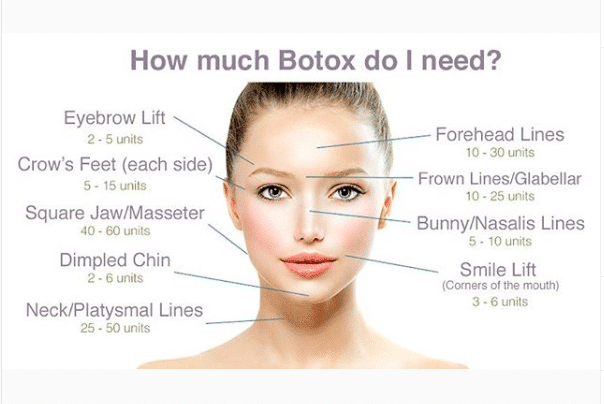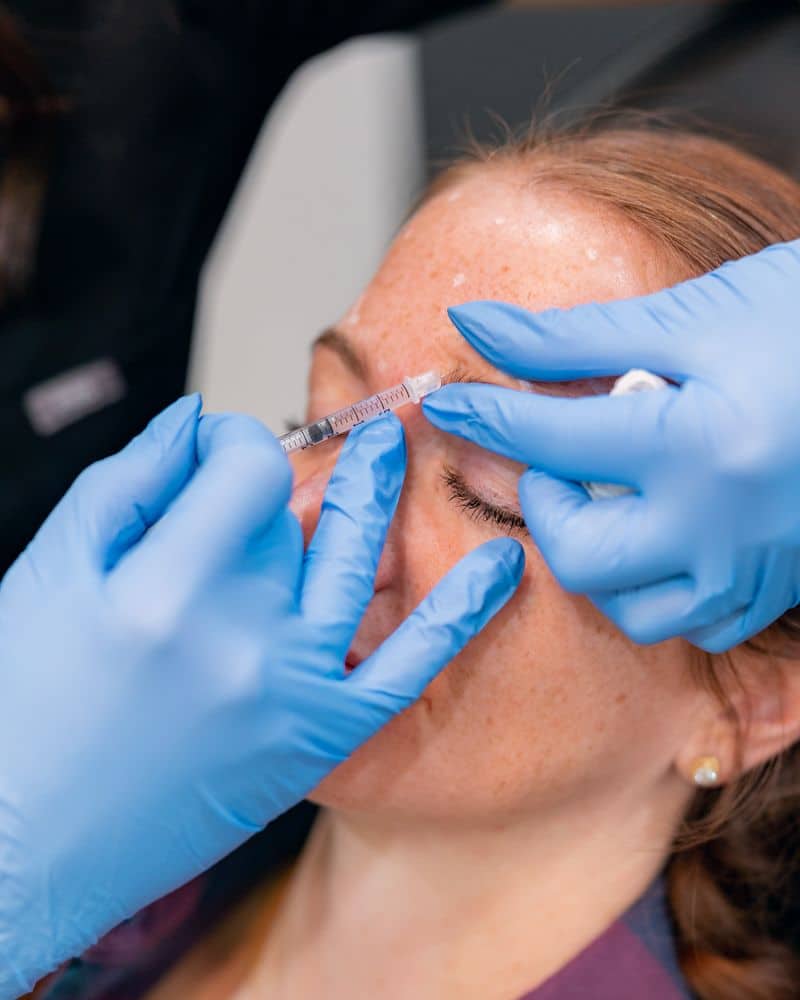Special Offer!
10% off Botox, Dysport & Fillers If you donate any cat/dog food, beds, or blankets!
How Do Wrinkles Form?
Wrinkles form in a few different ways. As the skin ages, there is less collagen and elastin production to keep it firm and stretchy. Without these characteristics, the skin is thinner and more susceptible to wrinkles and creases. Some of these creases, such as those that develop around the nose and mouth, occur when volume is lost in another area of the face. In the case of nasolabial folds, creases deepen as the mid-face becomes flatter. Some wrinkles form over time due to repetitive muscle movements. We use particular muscles for particular expressions.
The persistent use of muscles causes them to stay tense to some degree. When coupled with the loss of firmness and elasticity, this muscle contraction, however slight, results in permanent etchings on certain parts of the face. Called dynamic wrinkles, these concerns include frown lines, crow’s feet, and more.
What is BOTOX® Cosmetic?
BOTOX® Cosmetic is a purified liquid which inactivates the muscles which cause undesirable facial expressions and wrinkles. It is a highly concentrated derivative of the bacterial substance which causes botulism, but the doses are so low and the sites of administration so specific that the effects are strictly isolated to the small muscles which are targeted for treatment. It has been used for years to treat patients with certain muscular disorders. More recently, BOTOX® has been getting attention as an anti-wrinkle treatment that is quick and convenient with minimal side effects.
Click to View Injectables Photos


How BOTOX Works
Wrinkles are formed over time as the facial muscles contract to laugh, smile or frown. As these muscles contract, lines are worn into the skin, resulting in each individuals unique pattern of facial wrinkles. BOTOX® works by attaching to the nerve terminals and blocking the action of chemical neurotransmitters. This prevents the muscles from contracting, allowing the skin to relax reducing or even eliminating the overlying wrinkles.
We use a micro needle to inject a small amount of BOTOX® into the tiny muscles in the area around the wrinkle(s). Pain is minimal and most patients compare the sensation to a bug bite. Injections are normally given every four to six months since the effects of the treatment diminish over time. Usually, results are seen within the first few days following injection. The duration of benefit is often extended with each successive treatment, therefore the second treatment often lasts longer than the first, and so on.
BOTOX® has a long term safety record. Since the early ’90’s, BOTOX® has been used to help patients who suffer from blepharospasm, a muscular disorder that makes it difficult, if not impossible to normally open the eye. BOTOX® use is not limited to the face. It can be used to correct many muscle spasms such as voice box spasms and neck spasms.
Because everyone’s anatomy is a little different, the intensity and duration of BOTOX® effect varies somewhat from person to person. The intent is not to cause complete paralysis of the treated muscle, but to weaken them enough to cause the lines to relax and diminish visibly.
The FDA has approved BOTOX® for use on the vertical “frown” lines between the eyebrows but it is commonly used for treatment of the horizontal lines on the forehead and “crows feet” too. It can also help with the bands of muscles at the front of the neck. Newer applications can shape facial expression by raising the brows and corners of the mouth. BOTOX® treatments are highly effective, and in most people will create a more alert, refreshed and younger appearance. Often, depending on the lines or wrinkles treated, BOTOX® can produce a friendlier, less “stern” look, too.
Patient Testimonial
"The environment is cozy and welcoming. The staff is always so sweet. I’m always very pleased with my botox. I’ve never been left with a “hood brow”"
BOTOX Treatment Areas
Botox is commonly used to treat the following:
- Glabellar lines (frown lines)
- Crow’s feet at the outer corners of the eyes
- Horizontal forehead lines
- A heavy or droopy brow line
- Platysmal bands on the neck
- Excessive sweating
- Contracted masseter muscles caused by clenching the jaw

What to Expect during Your First BOTOX Treatment
At your first Botox treatment, you can expect to sit and talk with a friendly, experienced provider. The first step in developing the right treatment plan is to get to know your concerns and objectives. A consultation will go over what Botox is used for and how it may work to address your needs. Your provider may also discuss other injectables if relevant. Because Botox is only used to treat dynamic wrinkles, some concerns are better addressed with other products or modalities. When discussing what Botox is used for and what it can achieve, your provider will also ask about your expectations. It is important to have realistic goals. Otherwise, you risk dissatisfaction with the outcome of your treatment. Finally, after developing a plan that is unique to you, your provider will inform you how many units of Botox or other products they plan to use and how much the treatment will cost. The consultation phase of treatment usually takes 30 minutes or less. Injections can be administered immediately.

BOTOX vs DYSPORT
Botox and Dysport are very similar. Both are a type of botulinum type A used to relax muscles that cause wrinkles, the most common being deep forehead lines, frown lines and crows feet. Both products are similar, but some prefer one over the other. Dysport is a smaller-sized molecule so its unit measurement is different than Botox but calculating equivalent dosing is easy. This is why one unit of Dysport is cheaper than Botox, but keep in mind that you will need more units of Dysport to equal 1 unit of Botox. (There are 100 units in a bottle of Botox and 300 in a bottle of Dysport yet the cost is equivalent). In the end, except for clinics running specials for one or the other, the cost of the treatment is basically the same.
Botox entered the US market before Dysport but Dysport was widely used in Europe long before its availability here. Both have a high safety profile and both can be used on other parts of the face and body. Both Dysport and Botox must be injected every 3-6 months. Both show similar efficacy and side effects, and in most double-blind clinical studies both the patient and the doctor were unable to tell the results apart.
There has been much discussion about the differences (if any) between Botox and Dysport. The differences are subtle enough that there is not universal agreement but there are a few things most Physicians and RN Injectors do agree on:
- Dysport has a slightly quicker onset (usually 2-5 days, while Botox starts working in 4-6). Occasional reports suggest that Dysport might last a little longer than Botox but every treatment varies a little and if there is a difference, it is subtle at best. In truth, the dose given is more important than the product for longer results.
- Dysport has more diffusion or spread, therefore you may get away with slightly fewer injections.
- Some patients report that Dysport gives a more natural overall look or not such a “heavy” feeling as Botox. Others feel that Botox gives a better “freeze” if that is what they desire. (Keep in mind that these types of reports are totally subjective and subtle at best!)
- It appears that a small number of people develop antibodies against Botox, rendering it ineffective. Dysport does appear to provide an alternative for these individuals since it is a different molecule and not susceptible to the Botox antibody.
Both Botox and Dysport currently have rebates available from their manufacturer. The program for Botox is called Brilliant Distinctions and the program for Dysport is Galderma Rewards.
Ultimately, it is far more important WHO is injecting your Botox or Dysport, than which of these two products is used. Great results come from an experienced injector, not the product! Injection technique is far more important than which brand is injected, so seek out an experienced injector. Don’t hesitate to ask for educational background, experience, or credentials!
How Long Does BOTOX last?
Botox can last anywhere from 3 to 6 months in most cases. The results of treatment wear off gradually as the toxin loses efficacy and muscles start to tighten once again. How quickly this happens can depend on several factors, including patient age, the frequency and intensity of facial expressions, and lifestyle habits that may age the skin more quickly.
How Often Should I Get BOTOX Injections?
Botox touch-ups can safely be scheduled every 3 months. The average period between touch-ups is about 12 weeks. There is no firm guideline about Botox treatments except to wait at least 90 days before getting additional treatment. After this time frame, your touch-up schedule is really up to you and how you feel about your appearance as the product wears off.
Do BOTOX Injections Require Recovery Time?
There is no downtime to speak of after getting Botox. However, providers generally advise patients to avoid lying flat for 4 hours after this treatment. The reason is that lying down may make it easier for Botox to spread from the direct treatment area and cause muscle relaxation where it isn’t wanted. If this happens, the muscle weakness will have to run its natural course of 3 to 4 months.
In addition to remaining upright for the first 4 hours after Botox injections, patients should avoid strenuous exercise, sweating, and using makeup. These can introduce bacteria into injection sites and cause infection or irritation.
Are BOTOX Injections Safe?
Botox has been used for more than twenty years as a cosmetic drug. Before that time, the botulinum toxin ingredient had been used therapeutically, which it still is today. The amount of botulinum toxin in Botox is minute and considered very safe for most people.
Schedule a Consultation Today
To learn more about our services or to schedule an injectable consultation with Dr. Rachel Walker, call 972-661-5077 or click here to send us an appointment request form. Our plastic surgery practice serves Dallas, Texas, and surrounding areas.

